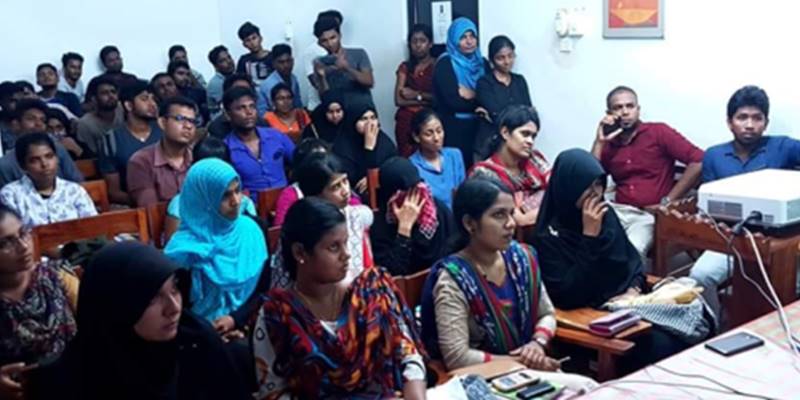By Hina Farooq
LAHORE: An exhibition of the South Asian Association and Regional Corporation (SAARC) students of the Beaconhouse National University on multi art was opened at the Alhamra Art Gallery on Monday.
As many as 23 artists from the SAARC countries participated in the exhibition titled Polytych. They picked various ideas and themes for their work. The art pieces displayed at the exhibition reflected the students creativity, representing their vision about the city and the surroundings that they came across during their stay in Lahore for a year.
Among the most inspiring pieces of work was a mechanical scooter made up by Sajana Joshi from Nepal, taking her inspiration from the city transport. The embellished goatskin on the scooter remained the centre of attention for the audience.
Sajana told Daily Times, “I transform objects both man-made and organic into a non-functional creature by using various natural materials, for instance animal skin. It was strange for me to see two people cluttered on to a scooter, and I related the vehicle’s helplessness to the helplessness of animals.”
She said the most difficult part of her work was stitching the goatskin into a frame designed by her. She said she had found the city lively and full of life. She said that being a Nepali and new to the city, she had no problems while moving around. She said she was delighted by the transportation made of rickshaws, scooters and animal carts.
Ahmed Azmee from Maldives portrayed his feelings about the political turmoil in Pakistan. His paintings were in series showing difficulties arising out of the bombings and terrorist attacks in the country. In a painting, one day he found himself shot dead on a street. He said he had great memories of the city. He said Masala foods and female beauty were the specialties of Lahore, which he couldn’t find anywhere else in Pakistan.
Vidha Saumya from India narrated a story about how she arrived in Lahore and afterwards. She had printed 16 post cards showing pictures of various places of the city and something about her visits to the people.
She said she had everything right when she came to Pakistan five months ago, but she was shocked, fearing no return to her homeland, when she had heard about the state of emergency imposed in the country. She said she settled down, after some time, when she had seen people moving around with comfort, having no problems with the emergency rule. I thought I should do my artwork, instead of thinking about the unrest in the country, She added. She praised the city for its unforgettable, rich culture.
Four students from Bhutan exhibited their work. Barun Gurung displayed traditional art known as Thangka painting of Bhutan.
The Art of Thangka painting belongs to the exalted art of the body and includes the three stages of learning the painting of Thangka.
He said that in Thangka painting, the painter, before beginning his work, had to make his hand soft and flexible to produce a perfect image.
He said Lahore was full of cultural values, and he couldn’t forget the hospitality and warm welcome of the people. The Food Street had inspired him a lot, he added.
Ghulam Mujataba Wardak from Afghanistan made his rich motifs of calligraphy inspired from Islamic and Mughal art. He said the bold colours he had used in his work represented his country. He said he had made several friends in Lahore. He praised the citizen for showing the rich culture of the city.
The work of Musharrat Chaudhry from Bangladesh evolved around Pakistan’s recent political situation. She said she had started thinking about the situation and realised that she should produce something on freedom of speech, which, according to her, was being snubbed in the country. She learnt the word speak up in eight different languages of the SAARC countries to convey her message across.
She said the most important thing about Lahore was bilingual people speaking various languages like Punjabi, Urdu and other local languages.
Haroon Rauof Mughal from Pakistan painted the old Lahore scenario, as he had spent his childhood in the walled city  the old Lahore. He said living there was a privilege and an opportunity to revive the ancient history. He said, My father and I are inspired by the walled city and we have tried to preserve our heritage in our drawings. He said his father, Rauf Ahmed, had inspired him.
Janaka Senevirathna from Sri Lanka made designs on poverty and unemployment in Pakistan and in Sri Lanka. He focused on how people had become luxury oriented and had forgotten basic human needs. He said he liked Lahore because of its rich educational culture.



